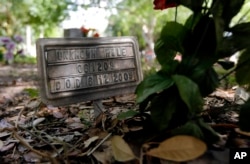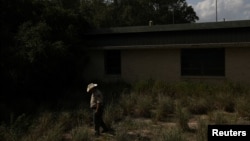While a lot of attention has focused on migrants crossing the U.S.-Mexico border between ports of entry, Brooks County, Texas, about 130 kilometers north of the Rio Grande, faces a separate immigration reality.
Migrants who crossed without authorization into the United States and were not identified or taken into custody often use the brushy mesquite region as a corridor to their next destination.
"Last year, we found a total of about five bodies or remains. Some were recent. Some had been there for a while," said Fernando Cervantes, a manager of a ranch outside of Falfurrias — the biggest town in Brooks County.
The ground is sandy. Temperatures often rise to 38 degrees Celsius (100 degrees Fahrenheit) and above. Landmarks are few, and it's easy for migrants to get lost and walk in circles. Since 2009, Brooks County has recovered the bodies of 943 migrants.
"We're standing here in the middle of this brush where there is no breeze at all. Whatever little breeze there is out in the open, you don't feel it here," Cervantes said, showing VOA around the ranch, including areas where migrants usually stop.
Falfurrias has one of the more than 30 Border Patrol brick-and-mortar checkpoints, generally 40 to 160 kilometers north of the Rio Grande. To avoid the checkpoint near Falfurrias, migrants walk for days across remote ranches. Some die from heat exhaustion, dehydration or hypothermia.
Cervantes recalled some of his encounters with lost migrants over the years. They often leave behind clothes, backpacks, bottles of dirty water, cellphone chargers and documents.
"[Last year], we found probably half a dozen people just wandering around. They were really, really close to death already. Luckily, we found them in time to get rescued, to get them help, to get them water," Cervantes said.
Cervantes said those found alive receive help and are turned over to Border Patrol authorities, who will process them under U.S. immigration law.
"But the summer is just starting. It's really getting hot. It's going to get hot in the next few months, and that's when we start looking. That's when we start finding people," he said.
Deadliest land crossing
Although the U.S. Border Patrol has recorded more than 8,000 migrant deaths along the U.S-Mexico border since 1998, Brooks County had more migrant deaths than any other South Texas county from 2012 to 2019, earning the name "the killing fields," according to a 2020 report by the Robert Strauss Center for International Security and Law at the University of Texas at Austin.
In response to a Freedom of Information Act request by VOA, the U.S. Customs and Border Protection reported that in fiscal 2022, border officials found the remains of 858 migrants along the U.S. southern border. In 2021, that number was 657. In 2020, 255. And in 2019, they found 295.
However, a 2022 Government Accountability Office report found that "CBP has not collected and recorded, or reported to Congress, complete data on migrant deaths," making the reported numbers an underestimate.
In fact, the International Organization for Migration (IOM) has categorized the Southwest border as the "deadliest land crossing in the world."
Rescuing migrants
When migrants get into trouble, they sometimes call 911, according to Brooks County Sheriff Benny Martinez. Those calls are answered by his office, he said.
Martinez estimates that the number of deaths is 10 times the number of bodies found, adding that more migrants die in Brooks County than along the Rio Grande. The sheriff's office works together with Border Patrol to rescue migrants.
"Every single scenario is different, depending on the call," Martinez said.
"In the hot days, which we usually have, within 72 hours, they pretty much be gone [dead] already. Now, Border Patrol is good. They have the EMT people. They go out there and apply the IVs quickly, and they start the rescue right there with a beacon," he told VOA.
And for those who don't survive?
"I have a morgue that I handle," Martinez said. "Brooks County has its own morgue, and through Border Patrol and some of the officers, they've gotten trained to kind of hydrate the fingerprint so we can get a good fingerprint. And once we identify these people, then we'll filter to the consulate. They'll identify the family members."
Unclaimed bodies are sent to Texas State University.
Local nonprofit
Eduardo Canales is director of the South Texas Human Rights Center in Falfurrias, a nonprofit that runs a missing person recovery program in cooperation with the Border Patrol.
Families call the center's missing migrant hotline hoping to find their loved ones. Staff at the center gather as much information as possible, including when the relatives last heard from the missing migrants. That information is then passed on to local authorities, who then send out search and rescue teams.
Canales said that in the past two years, more than 200 bodies were discovered in Brooks County alone and that finding missing people is difficult.
"A lot of people get stranded. They get left behind. They get sick. They don't know the terrain. … Unless we have GPS coordinates [from the migrants or their family], we're able to transfer them to Border Patrol or to searchers," he said.
The center is part of the Forensic Border Coalition, a group of scholars, forensic scientists and human rights organizations that work together to identify the remains of migrants found in the south Texas region. The group is pushing for a regional medical examiner system to serve Brooks County and also Hidalgo, Cameron, Starr and other Texas counties.
Canales has also created and maintained more than 144 water stations for migrants throughout Brooks County. Some have been vandalized over the years.
He often checks water stations at the intersection of Highways 285 and 281, one of the migrant routes headed toward San Antonio and Dallas for those who make it.
"[Migrants] are trying to make it to the big cities to work ... to blend in, you know? That's where the work is," Canales said.


